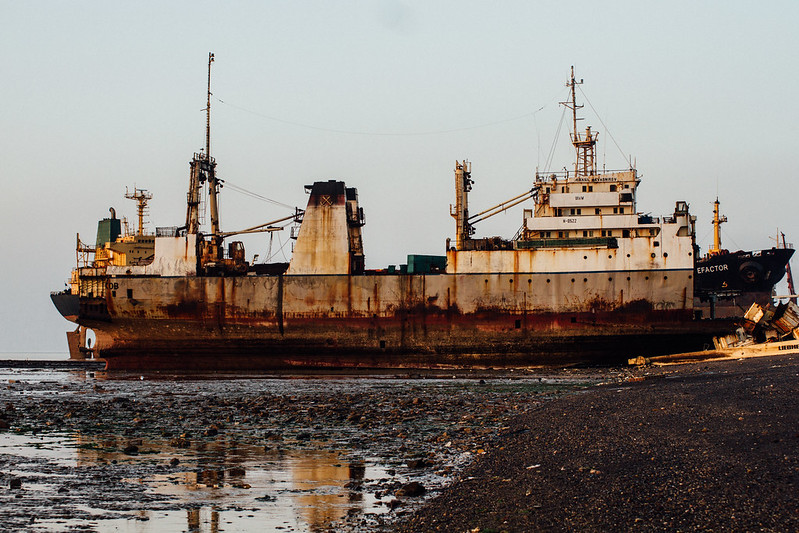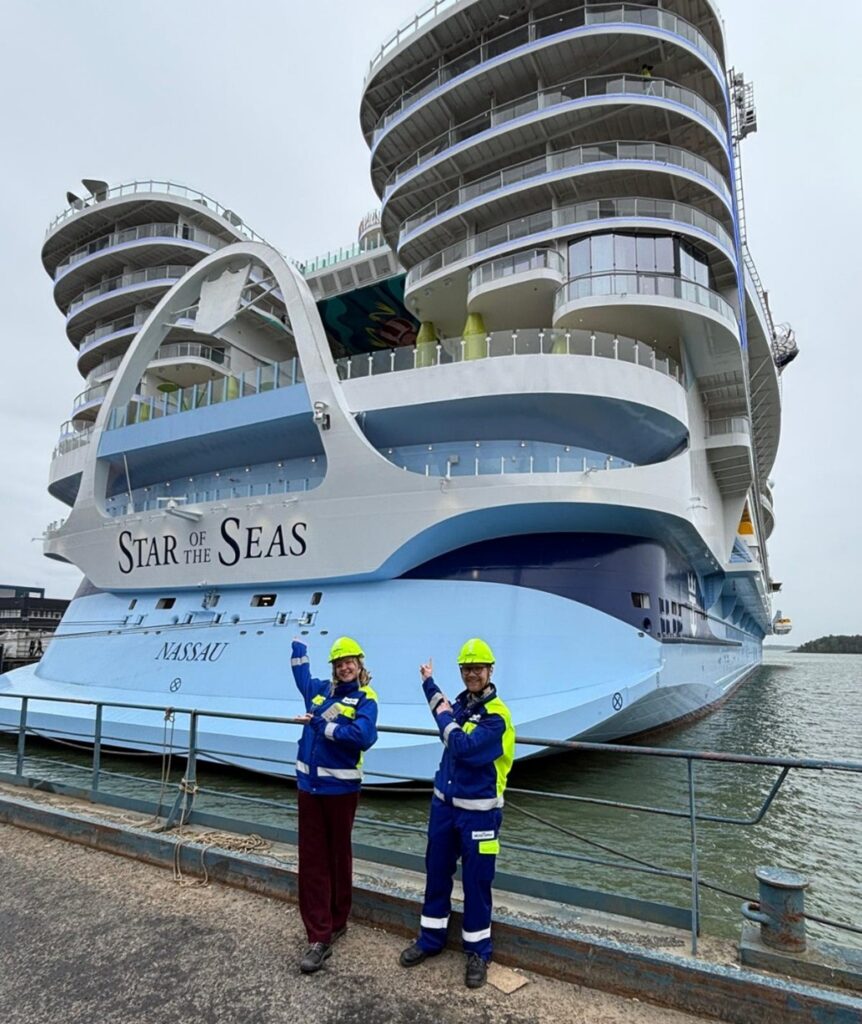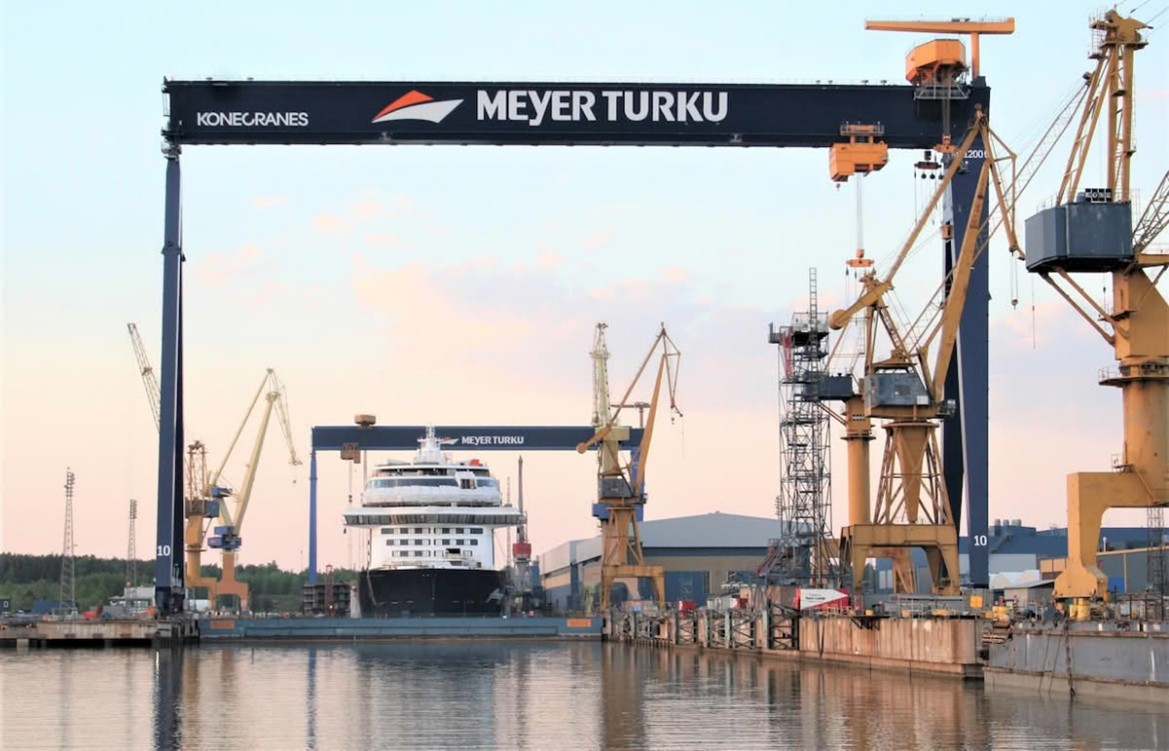The environmental impacts of the shipping industry from cradle to grave – a joint investigation from two Bachelor’s theses
Text: Amanda Nygren & William Nyholm
Cover image: Frode Rabbevåg (Store norske leksikon)
In 2024, a collaboration between Åbo Akademi University’s Centre for Sustainable Ocean Science (SOS) and Meyer Turku was initiated to explore ways of mitigating the shipping industry’s impact on biodiversity. This partnership led to the production of two bachelor’s theses in Environmental and Marine Biology: William Nyholm investigated the environmental effects of the construction and operational phases of ships, while Amanda Nygren focused on the dismantling process. From shipbuilding and active operation to final dismantling, we explored how each phase contributes to ecological degradation.
The shipping industry can be broadly divided into three distinct phases, each corresponding to a stage in a ship’s life cycle: the construction phase, where the vessel is built from scratch; the operational phase, during which it serves its economic purpose at sea; and finally, the demolition phase, where the ship is dismantled and its materials are recycled. Depending on the type of vessel, this cradle-to-grave journey typically spans between 20 and 40 years. In the name of circular economy, this life cycle offers a promising foundation for a sustainable maritime sector. To truly assess the environmental footprint of shipping, it is also essential to examine the direct ecological impacts associated with each phase.
During the shipbuilding phase, two primary sources of pollution can be identified: shipyard operations and surface treatment processes. Since ships are predominantly constructed from steel, shipyard activities largely revolve around cutting, welding, blasting, and assembling large steel structures. These industrial processes release hazardous air pollutants and particulate matter. While similar to general industrial pollution, the open-air nature of shipyards and their proximity to coastlines increase the risk of these pollutants entering marine ecosystems.
Surface treatment involves the application of paints and anti-fouling coatings. The painting of large steel surfaces emits substantial amounts of volatile organic compounds (VOCs), which are frequently cited in the literature as one of the most significant environmental threats from shipyards. However, most existing research has focused on the health impacts of VOCs on workers, leaving a gap in our understanding of their ecological effects. There is potential concern that VOCs may indirectly affect aquatic ecosystems by disrupting natural chemical signalling between organisms. To help reduce drag and fuel consumption, anti-fouling paints prevent the accumulation of organisms such as mussels and barnacles on the hull. The contained biocides, true to their function, cause direct toxic effects also on non-target marine species when leached into the water.
Compared to the shipbuilding phase, the environmental impacts of ship operations are far more extensively documented in scientific literature. Beyond the emission of greenhouse gases from heavy fuel oil combustion, ship operations also exert direct pressures on marine ecosystems through physical disturbances and the discharge of various wastewaters. Numerous studies have highlighted the occurrence of collisions on wildlife and the degradation of coastal ecosystems due to increased wave exposure.
More recently, research has begun to explore the behavioural effects of artificial light and underwater noise generated by ships, revealing subtle yet significant disruptions to marine life. Wastewater discharges—including black water, grey water, bilge water, and scrubber effluents—release cocktails of nutrients, toxins, and microplastics into the marine environment. These chemical pollutants can have both toxic and indirect effects, altering the behaviour and health of marine organisms and potentially disrupting entire ecosystems. Despite their potential ecological harm, the regulation on water discharges is surprisingly lacking.
Once a ship’s operating costs begin to outweigh its revenues, it is typically sold to a dismantling yard where it is broken down and its materials are recycled. Up to 80% of a ship’s structure is made of steel, which can be effectively reused. However, dismantling often takes place in low-income countries where health and environmental regulations are weak or poorly enforced. The largest shipbreaking yards are in Bangladesh, India, and Pakistan. Due to limited infrastructure, vessels are dragged ashore and dismantled directly on the beach, causing severe physical disruption to coastal habitats. This process leads to habitat destruction and significant shoreline erosion as vegetation is stripped away.

Ship hulls and ballast water are also major vectors for invasive species, while other wastewater discharges introduce pathogens and excess nutrients that cloud the water. In addition to unsustainable practices, the industry is associated with high levels of toxic exposure. Cutting and dismantling release particles from surface coatings and insulation materials—often containing heavy metals and other bioaccumulative substances—into the air, where they can travel long distances and enter the food web. Asbestos, once widely used for insulation, remains a lingering hazard despite being banned. Ships also contain large volumes of oil-based residues that pose serious health risks.
Because ship dismantling involves numerous stakeholders and complex logistics, implementing legal reforms and international regulations has proven difficult. As a result, both environmental health and worker safety are often sacrificed in pursuit of economic gain.
Shipping, as a mode of transport and carrier of goods, is as old as civilisation itself. Despite centuries of dependence on maritime trade and the fact that the vast majority of cargo today is transported by sea, our knowledge and regulation of the industry’s environmental impacts remain finite. By no means are we suggesting that modern shipping is an environmental catastrophe; emissions of greenhouse gases and contribution to climate change have been thoroughly assessed and greener means of transport are being developed. However, the impacts and cumulative effects on aquatic environments and biodiversity are yet to be fundamentally studied.
Thanks to the collaboration between Åbo Akademi University’s SOS Centre and Meyer Turku, we had the opportunity to visit the local shipyard in person. Jonas Martin, Environmental Engineer at Meyer, welcomed us with a tour of the site and offered insights into the shipbuilding process and the company’s current environmental work. At the time of our visit, sister ships to Icon of the Seas were under construction, a truly fascinating process. The shipyard was buzzing with activity, with workers in blue jackets and yellow helmets wherever you looked.
After exploring the site, we had a chance to briefly present and discuss our bachelor’s theses. The visit to Meyer Turku was an incredibly interesting experience, and we want to extend our sincere thanks to Jonas Martin and our supervisors who made the visit possible! Thanks to great supervision from Anna Törnroos-Remes and Heidi Herlevi, our theses were completed and we can title ourselves Bachelors of Science.

Authors
Amanda Nygren, student, Environmental and Marine Biology, ÅAU
William Nyholm, student, Environmental and Marine Biology, ÅAU



